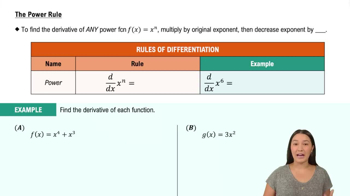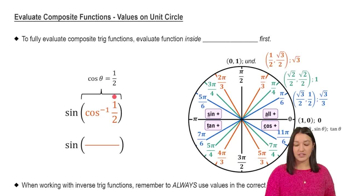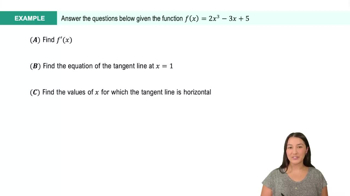Table of contents
- 0. Functions7h 52m
- Introduction to Functions16m
- Piecewise Functions10m
- Properties of Functions9m
- Common Functions1h 8m
- Transformations5m
- Combining Functions27m
- Exponent rules32m
- Exponential Functions28m
- Logarithmic Functions24m
- Properties of Logarithms34m
- Exponential & Logarithmic Equations35m
- Introduction to Trigonometric Functions38m
- Graphs of Trigonometric Functions44m
- Trigonometric Identities47m
- Inverse Trigonometric Functions48m
- 1. Limits and Continuity2h 2m
- 2. Intro to Derivatives1h 33m
- 3. Techniques of Differentiation3h 18m
- 4. Applications of Derivatives2h 38m
- 5. Graphical Applications of Derivatives6h 2m
- 6. Derivatives of Inverse, Exponential, & Logarithmic Functions2h 37m
- 7. Antiderivatives & Indefinite Integrals1h 26m
- 8. Definite Integrals4h 44m
- 9. Graphical Applications of Integrals2h 27m
- 10. Physics Applications of Integrals 2h 22m
3. Techniques of Differentiation
Basic Rules of Differentiation
Problem 56b
Textbook Question
Power and energy are often used interchangeably, but they are quite different. Energy is what makes matter move or heat up. It is measured in units of joules or Calories, where 1 Cal=4184 J. One hour of walking consumes roughly 10⁶J, or 240 Cal. On the other hand, power is the rate at which energy is used, which is measured in watts, where 1 W = 1 J/s. Other useful units of power are kilowatts (1 kW=10³ W) and megawatts (1 MW=10⁶ W). If energy is used at a rate of 1 kW for one hour, the total amount of energy used is 1 kilowatt-hour (1 kWh = 3.6×10⁶ J) Suppose the cumulative energy used in a large building over a 24-hr period is given by E(t)=100t + 4t² − (t³ / 9) kWh where t = 0 corresponds to midnight.
The power is the rate of energy consumption; that is, P(t) = E′(t) Find the power over the interval 0 ≤ t ≤ 24.
 Verified step by step guidance
Verified step by step guidance1
Step 1: Understand that power is the derivative of energy with respect to time. Given the energy function E(t) = 100t + 4t^2 - (t^3 / 9), we need to find its derivative to determine the power function P(t).
Step 2: Differentiate the term 100t with respect to t. The derivative of 100t is 100, as the derivative of t with respect to t is 1.
Step 3: Differentiate the term 4t^2 with respect to t. Using the power rule, the derivative of 4t^2 is 8t, since the power rule states that d/dt [t^n] = n*t^(n-1).
Step 4: Differentiate the term -(t^3 / 9) with respect to t. Again using the power rule, the derivative is -(3/9)t^2, which simplifies to -(1/3)t^2.
Step 5: Combine the derivatives from Steps 2, 3, and 4 to form the power function P(t). Therefore, P(t) = 100 + 8t - (1/3)t^2. This function represents the power over the interval 0 ≤ t ≤ 24.
 Verified video answer for a similar problem:
Verified video answer for a similar problem:This video solution was recommended by our tutors as helpful for the problem above
Video duration:
4mPlay a video:
Was this helpful?
Key Concepts
Here are the essential concepts you must grasp in order to answer the question correctly.
Energy and Power
Energy is the capacity to do work, measured in joules (J) or calories (Cal), while power is the rate at which energy is consumed or produced, measured in watts (W). Understanding the distinction between these two concepts is crucial, as energy quantifies the total work done, whereas power indicates how quickly that work is performed.
Recommended video:

The Power Rule
Derivative in Calculus
The derivative of a function represents the rate of change of that function with respect to its variable. In this context, finding the power as the derivative of the energy function E(t) allows us to determine how energy consumption changes over time, which is essential for analyzing the building's energy usage.
Recommended video:

Fundamental Theorem of Calculus Part 1
Units of Measurement
Understanding the units of measurement for energy (joules, kilowatt-hours) and power (watts, kilowatts) is vital for interpreting the results of calculations. Converting between these units, such as knowing that 1 kWh equals 3.6 million joules, helps in accurately assessing energy consumption and power output over specified intervals.
Recommended video:

Evaluate Composite Functions - Values on Unit Circle

 3:59m
3:59mWatch next
Master Derivatives of Linear Functions with a bite sized video explanation from Callie
Start learningRelated Videos
Related Practice






